Digital Posters
Innovative Receive Coils
ISMRM & SMRT Annual Meeting • 15-20 May 2021

| Concurrent 2 | 19:00 - 20:00 |
1591.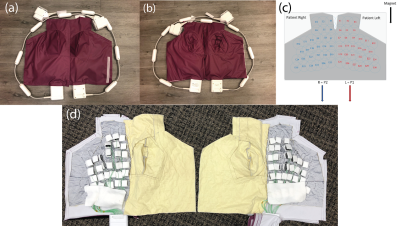 |
Ultra-Flexible, High-Resolution, 60-Channel RF Coil for Supine Breast Imaging
Jana Vincent1,2,3, Clyve Konrad Follante1, Ersin Bayram4, Lloyd Estkowski5, Ty Cashen6, Mark Giancola1, Victor Taracila1, Yun-Jeong Stickle1, Lalit Rai1, Venkata Malasani1, Nicole Wake7,8, Vichiry Yan1, Robert Stormont9,
Joseph Rispoli2,10, and Fraser Robb1
1GE Healthcare Coils, Aurora, OH, United States, 2Weldon School of Biomedical Engineering, Purdue University, West Lafayette, IN, United States, 3Basic Medical Sciences, Purdue University, West Lafayette, IN, United States, 4Global MR Applications & Workflow, GE Healthcare, Houston, TX, United States, 5Global MR Applications & Workflow, GE Healthcare, Waukesha, WI, United States, 6Global MR Applications and Workflow, GE Healthcare, Madison, WI, United States, 7Albert Einstein College of Medicine, Montefiore Medical Center, Bronx, NY, United States, 8Center for Advanced Imaging Innovation and Research, Department of Radiology, NYU School of Medicine, New York, NY, United States, 9GE Healthcare, Waukesha, WI, United States, 10School of Electrical & Computer Engineering, Purdue University, West Lafayette, IN, United States
Typically, breast MR scans are performed prone; however, there are advantages to supine imaging. Here we present the first 60-channel, high-resolution, flexible breast coil. The coil can be run with the embedded posterior coil for a total of 90-channels in the FOV. In addition to better image quality, with such a high channel count, an acceleration of up to 5 by 2 was possible. Due to the structured shape, breast tissue was kept in place for the duration of the scan and women with cup sizes up to a DD could be accommodated. Straps provide adjustments for smaller bust sizes.
|
|||
1592.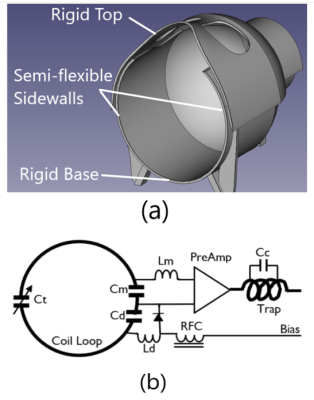 |
A Continuously Adjustable 32-Ch Head Coil Array for MRI at 3T
Yunsuo Duan1, Jiacheng Wang2, Feng Liu1, Rachel Marsh1, and Thomas J. Vaughan3
1MR Research, Department of Psychiatry, NYSPI and Columbia University, New York, NY, United States, 2Department of Electrical Engineering, New York University, New York, NY, United States, 3ZMBBI, Columbia University, New York, NY, United States
Close fitting is extremely crucial for RF coil arrays in order to maximize sensitivity. It is impossible to closely fit for all subjects of various head sizes using rigid head coil arrays. We presented a novel design of partially flexible 32-channel coil array to address the issue. The inner dimensions of the coil array can be smoothly adjusted from 180mmx220mm to 220mmx 260 mm, which fit for almost all head sizes of adult human subjects. The experiment results showed high imaging quality within the adjustable ranges. The coil array is highly practical for both research and clinical settings.
|
|||
1593.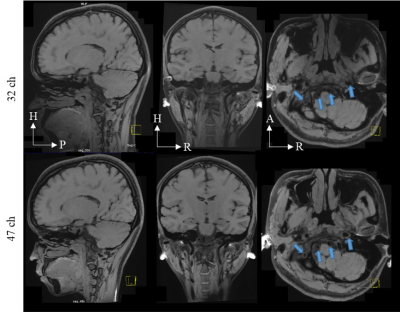 |
A Quadrature Birdcage/47Rx Coil Array for Acceleration Images on 3 T MRI
Jo Lee1,2, Sen Jia1,2, Liu Liu3, Xiaoliang Zhang4, and Ye Li1,2
1Paul C. Lauterbur Research Center for Biomedical Imaging, Shenzhen Institutes of Advanced Technology, Chinese Academy of Sciences, Shenzhen, China, 2Shenzhen Key Laboratory for MRI, Shenzhen, China, 3United Imaging Healthcare, Shanghai, China, 4Department of Biomedical Engineering, State University of New York, Buffalo, NY, United States
We designed and built a quadrature-birdcage/ 47Rx head coil array for accelerated images on 3 T MRI. A 32-channel commercial head coil was used as a comparison. The inverse g-factor images and accelerated anatomical images both show that the 47-channel head coil has better acceleration ability. EPI images and cerebrovascular images further verified that the 47-channel head coil is capable of human’s brain studies.
|
|||
1594.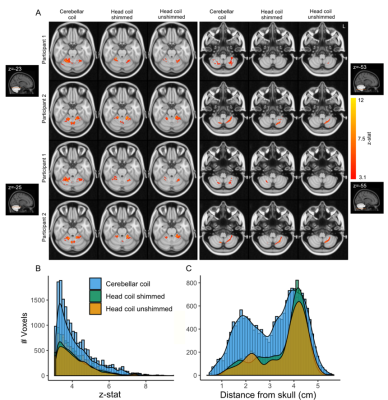 |
A dedicated coil for cerebellar fMRI
Nikos Priovoulos1, Thomas Roos1, Ozlem Ipek2, Ettore Meliado3, Richard Nkrumah2, Dennis Klomp3, and Wietske van der Zwaag1
1Spinoza Center, Amsterdam, Netherlands, 2King’s College London, London, United Kingdom, 3University Medical Center Utrecht, Utrecht, Netherlands
The function of human cerebellum is underexplored in vivo, due to its small size and its placement at the bottom of the brain where transmit fields are suboptimal at 7Tesla. Here, we combined 2 dense coil arrays of 16 small surface receive elements each with a transmit array of 3 antennas elements. Our results show improved B1+ and SNR close to the surface as well as g-factor gains compared to a whole-head commercial coil. This resulted in large gains in the surface (< 3.5cm) in the spatial extent of the BOLD activation, at the cost of increased signal inhomogeneity.
|
|||
1595.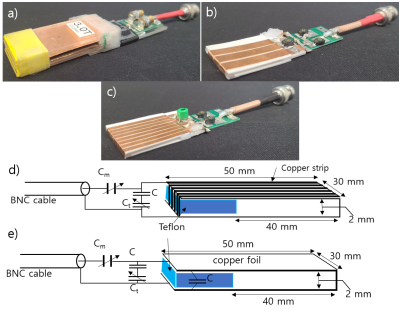 |
A novel multi-turn histology RF coil design for micro-histological slide imaging
Byung-Pan Song1,2, Sung-Jun Yoon1, Hyeong-Seop Kim1,2, Kyoung-Nam Kim3, and Seung-Kyun Lee1,2,4,5
1Department of Biomedical Engineering, Sungkyunkwan University, Suwon, Korea, Republic of, 2Department of Intelligent Precision Healthcare Convergence, Sungkyunkwan University, Suwon, Korea, Republic of, 3Department of Biomedical Engineering, Gachon University, Incheon, Korea, Republic of, 4Department of Physics, Sungkyunkwan University, Suwon, Korea, Republic of, 5IBS Center for Neuroscience Imaging Research, Suwon, Korea, Republic of
MR microscopy can provide high-resolution measurement of MR properties of biological and artificial tissues that can be compared with optical imaging. In such experiments, low signal-to-noise ratios (SNR) of a common clinical RF coil with a low filling factor will be a challenge. So, we propose a novel, multi-turn histology coil for imaging microscopic tissue histology slices with substantially higher SNR in clinical MRI scanner compared to the previous design for microscopy tissue imaging.
|
|||
1596. |
How far Should Coil Coverage be Extended to Reach Optimum Simultaneous Multi-Slice Acceleration in Cardiac MRI?
Anpreet Ghotra1, Sam-Luca JD Hansen1, Robin Etzel1, Mirsad Mahmutovic1, Alina Scholz1, Nicolas Kutscha1, Matthäus Poniatowski1, Markus W May1, Choukri Mekkaoui2, and Boris Keil1
1Institute of Medical Physics and Radiation Protection, TH Mittelhessen University of Applied Sciences, Giessen, Germany, 2Harvard Medical School, Massachusetts General Hospital, Department of Radiology, A.A. Martinos Center for Biomedical Imaging, Boston, MA, United States
Even with commonly used k-space subsampling acceleration methods, cardiac MRI still suffers from relatively slow acquisition speed which imposes limitations in spatial and temporal resolution and volumetric coverage when imaging the moving heart. The recently introduced simultaneous multi-slice (SMS) acceleration technique offers the potential to acquire multiple slices which can substantially increase myocardial coverage without compromising in-plane spatial resolution. However, to disentangle the collapsed slices, array coils must provide enough sensitivity variation along the slice direction. Therefore, in this simulation study, we evaluated the coverage of the cardiac array coil to maximize SMS encoding performance.
|
|||
1597.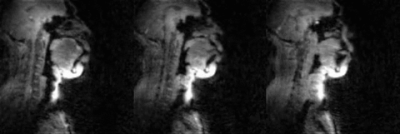 |
A novel 16 channel flexible coil for highly accelerated upper-airway MRI
Wahidul Alam1, Rushdi Zahid Rusho1, Scott Reineke2, Madavan Raja2, Stanley Kruger3, Joseph M. Reinhardt1, Junjie Liu4, Douglas Van Daele5, and Sajan Goud Lingala1,2
1Roy J Carver Department of Biomedical Engineering, University of Iowa, iowa city, IA, United States, 2ScanMed LLC, Omaha, NE, United States, 3Department of Radiology, University of Iowa, iowa city, IA, United States, 4Department of Neurology, University of Iowa, iowa city, IA, United States, 5Department of Otolaryngology, University of Iowa, iowa city, IA, United States
We develop a novel custom airway coil that offers significant boost in signal sensitivity in several regions of the upper-airway such as tongue, soft-palate, pharynx, glottis. Our coil is designed to be flexible for easy conformation to the subjects face/neck anatomy. With the proposed coil, we demonstrate robust parallel MRI performance up to R=4-5 fold for static imaging with 1-D under-sampling, and highly accelerated dynamic imaging (up to R~27 fold) of swallowing, and airway shaping due to variations in breathing.
|
|||
1598.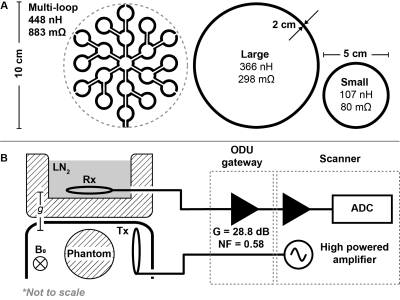 |
Signal-to-noise of thermal versus hyperpolarized MRI as a function of field strength and receive coil temperature
Mohammed M. Albannay1, Charles McGrath1, Alexander Jaffray1, and Sebastian Kozerke1
1University and ETH Zurich, Institute for Biomedical Engineering, Zurich, Switzerland
In this work SNR of thermal and hyperpolarized MRI is simulated based on first principles. It is demonstrated that detection of hyperpolarized nuclei is more favourable at lower field strengths (e.g. 0.75T) where prolonged T2* values and reduced readout bandwidth lead to higher SNR compared to standard clinical field strengths. Moreover, SNR benefits of receive coil cooling are experimentally studied on a clinical 3T Philips Achieva scanner that has been ramped down to a field strength of 0.75T.
|
|||
1599.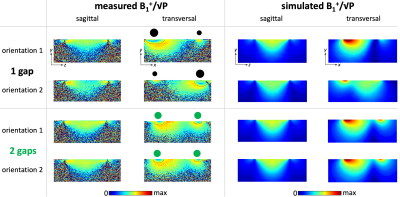 |
Performance comparison of a 10 cm single-gap vs. double-gap coaxial coil used as a transceiver for 7T MRI
Lena Nohava1,2, Andre Kuehne3, Elmar Laistler1, and Sigrun Roat1
1High Field MR Center, Center for Medical Physics and Biomedical Engineering, Medical University of Vienna, Vienna, Austria, 2BioMaps (Laboratoire d'Imagerie Biomédicale Multimodale Paris Saclay), Université Paris-Saclay, CEA, CNRS, Inserm, Orsay, France, 3MRI.TOOLS GmbH, Berlin, Germany
In this work, we investigated the performance differences between a flexible single-gap coaxial coil operated far above self-resonance and a double-gap coaxial coil operated on self-resonance at 7T. Based on electromagnetic simulations and MRI results it is demonstrated that in the single-gap design the current distribution on the outside of the coaxial shield is strongly inhomogeneous. This leads to a strong dependence of the Tx performance on the coil orientation relative to B0. In contrast, the double-gap design results in homogeneous current distribution and orientation-independent Tx performance.
|
|||
1600. |
Additive manufacturing of MRI coils by printing and electroplating a conductive polymer
Christoph Michael Schildknecht1 and Klaas Paul Pruessmann1
1Institute for Biomedical Engineering, ETH Zurich and University of Zurich, Zürich, Switzerland
In this work, additive manufacturing of MRI coils by selectively electroplating a conductive polymer is demonstrated, enabling the fabrication of complex coil geometries with high accuracy and reproducibility. Using a low-cost multi-material FDM 3D printer, deposition of insulating and conductive elements has been achieved in a single process, followed by straightforward electroplating. The proposed approach is demonstrated by an example of a wrist coil, including in-vivo imaging at 3T.
|
|||
1601.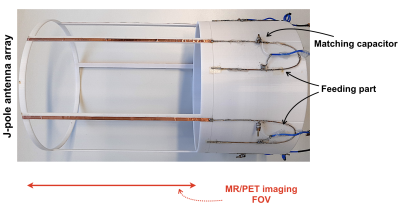 |
Novel antenna array for ultra-high field MR-PET
Chang-Hoon Choi1, Suk-Min Hong1, Jörg Felder1, Lutz Tellmann1, Jürgen Scheins1, Elena Rota Kops1, Christoph Lerche1, and N. Jon Shah1,2,3,4
1INM-4, Forschungszentrum Juelich, Juelich, Germany, 2JARA-BRAIN-Translational Medicine, Aachen, Germany, 3Department of Neurology, RWTH Aachen University, Aachen, Germany, 4INM-11, Forschungszentrum Juelich, Juelich, Germany
Hybrid MR-PET is a powerful imaging technique that capitalised on the advantages of both modalities. However, to optimise these capabilities, the MRI antenna, which is located inside the effective PET detection area, needs to be operated without compromising any aspects of system performance or image quality compared to the stand-alone instrumentation. Here, we report a novel J-pole antenna array concept which is gamma radiation transparent. Furthermore, this unique feature provides advantages in MR-only applications by reducing the coupling effect between cables and the antenna elements and by lowering the potential specific absorption rate burden.
|
|||
1602.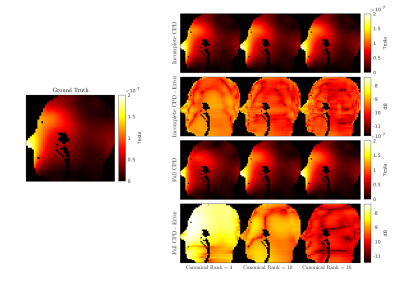 |
Decomposition of the incomplete volume-surface integral equation matrices for MR coil simulations
Ilias Giannakopoulos1, Georgy Dmitrievich Guryev2, Jose Enrique Cruz Serralles2, Ioannis Georgakis1, Luca Daniel2, Jacob White2, and Riccardo Lattanzi1,3,4
1Center for Advanced Imaging Innovation and Research (CAI2R), Department of Radiology, New York University Grossman School of Medicine, New York, NY, United States, 2Department of Electrical & Computer Engineering, Massachusetts Institute of Technology, Cambridge, MA, United States, 3The Bernard and Irene Schwartz Center for Biomedical Imaging (CBI), Department of Radiology, New York University Grossman School of Medicine, New York, NY, United States, 4Vilcek Institute of Graduate Biomedical Sciences, New York University Grossman School of Medicine, New York, NY, United States
The volume-surface integral equation (VSIE) method is used for rapid and accurate simulations of electromagnetic fields in magnetic resonance imaging. For the case of a 7T array and a numerical head phantom, we constructed the VSIE coupling matrix that models the interactions between the coil and the scatterer. We reshaped the columns of the matrix as incomplete 3D tensors. We investigated how the low rank properties of these tensors, could be exploited to compress the coupling matrix, by expressing the tensors in their canonical form. We showed that an excellent compression could be achieved with an error lower than 2%.
|
|||
1603.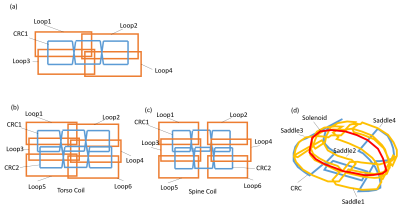 |
Flexible Body Coil for Vertical Field MRI using Loop/CRC RF Coil Array
Yosuke Otake1, Takeshi Taniguchi1, Hideta Habara1, Christophor Napier2, Errol Brissett2, Shawn Etheridge2, Masayoshi Dohata1, and Kazuyuki Kato1
1Healthcare Business Unit, Hitachi, Ltd., Tokyo, Japan, 2Hitachi Healthcare Americas, Twinsburg, OH, United States
To improving the SNR and the usability in the vertical field MRI(Open MRI), a flexible body(spine/torso) coil has been developed. The coil consists of loop/CRC hybrid multi-channel array (LCA). The performance of the coil was evaluated in phantom experiment at 1.2T vertical field MRI. The SNR of the coil using LCA was 46% better than a conventional body coil. This technique will contribute to improve the performance of the vertical field MRI.
|
|||
1604.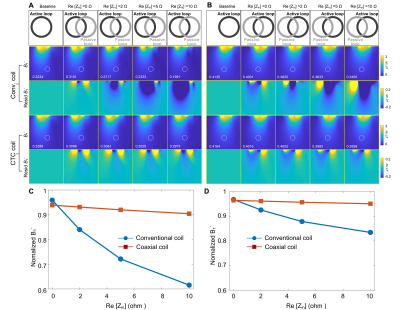 |
Design of an over-overlapped wearable 3T pelvic phased array using a capacitor-terminated coaxial coil
Ming Lu1,2, Junzhong Xu1,2, Sandeep S. Arora3, John C. Gore1,2, and Xinqiang Yan1,2
1Vanderbilt University Institute of Imaging Science, Vanderbilt University Medical Center, Nashville, TN, United States, 2Department of Radiology and Radiological Sciences, Vanderbilt University Medical Center, Nashville, TN, United States, 3Department of Radiology and Biomedical Imaging, Yale University School of Medicine, New Haven, CT, United States
Prostate cancer is one of the leading causes of cancer death among men in the US. MRI is a useful tool to assess the presence and extent of prostate cancer, and diagnostic accuracy relies on acquiring images with high SNR. We aimed to improve the performance of such arrays by using flexible coaxial coil technology and an over-overlapping layout to increase the number of coil elements without sacrificing coil size.
|
|||
1605.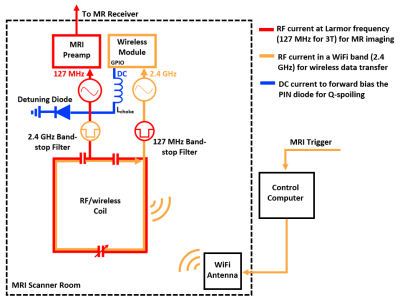 |
An Integrated Radio-Frequency/Wireless (iRFW) Coil Design for Wireless Q-Spoiling During MR Imaging
Jonathan Cuthbertson1,2, Trong-Kha Truong1,2, Jasmine Chen1,2, Fraser Robb3, Allen W. Song1,2, and Dean Darnell1,2
1Medical Physics Graduate Program, Duke University, Durham, NC, United States, 2Brain Imaging Analysis Center, Duke University, Durham, NC, United States, 3GE Healthcare, Aurora, OH, United States
The integrated RF/wireless coil design allows for simultaneous MR image acquisition and wireless data transfer with the same coil element in order to reduce the number of wired connections in the scanner. Here, we use this coil design to wirelessly transmit the scanner trigger signal to perform the Q-spoiling required for MR imaging. Proof-of-concept experiments in a phantom showed that this coil design was able to accurately and reliably transmit the scanner trigger from the adjacent console room to a WiFi-enabled module in the scanner bore, while having minimal impact on the image SNR or wireless performance.
|
|||
1606.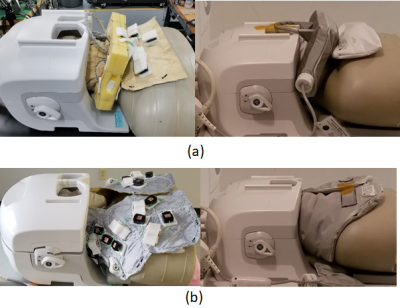 |
Universally Sized, High-Resolution and ASSET Optimized AIR Cervical Coils Combined with a 48-Channel Head Coil for 3T MRI
Yun-Jeong Stickle1, Clyve Konrad Follante1, Mark Giancola1, David Anderson1, Fraser Robb1, Thomas Stickle1, Robert Stormont2, Holly Blahnik2, Ho-Joon Lee3, Young Han Lee4, and Darryl B. Sneag5
1GE Healthcare Coils, Aurora, OH, United States, 2GE Healthcare, Waukesha, WI, United States, 3Haeundae Paik Hospital, Busan, Korea, Republic of, 4Severance hospital, Yonsei University, Seoul, Korea, Republic of, 5Hospital for Special Surgery, New York, NY, United States
Conventional high density phased-array head/neck coils are designed to tightly conform to head/neck region to increase SNR and accommodate higher acceleration, which in turn limits space and their use for larger patients. This study shows results for two different universally sized AIR (Adaptive Imaging Receive) neck/cervical spine coils combined with a 48-Channel head coil to provide higher SNR and improved acceleration compared to a conventional coil. 3T MRI setups to image the head/neck, carotids and cervical spine were designed and constructed. Phantom measurements and high-resolution in vivo imaging were performed to demonstrate design performance.
|
|||
1607.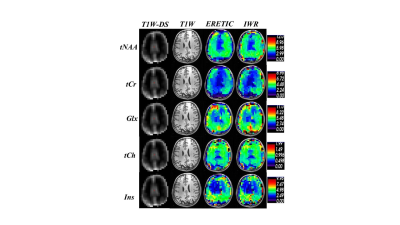 |
Development of a multiplexed ERETIC-RF array coil for quantitative whole brain 3D-MR spectroscopic imaging (MRSI)
Bijaya Thapa1,2, Bernhard Strasser1,2, Xianqi Li1,2, Jason Stockman1,2, Azma Mareyam1, Boris Keil3, Zhe Wang4, Stefan Carp1,2, Yulin V. Chang4, Lawrence Wald1,2, Philipp Hoecht Hoecht5, and Ovidiu Andronesi1,2
1Dept. of Radiology, MGH, A. A. Martinos Center for Biomedical Imaging, Charlestown, MA, United States, 2Harvard Medical School, Boston, MA, United States, 3Mittelhessen University of Applied Science, Giessen, Germany, 4Siemens Medical Solutions USA, Charlestown, MA, United States, 5Siemens Healthcare, Erlangen, Germany An Electronic REference To access In vivo Concentrations (ERETIC) to absolutely quantify the brain metabolites for 3D-MRSI using an array coil was developed. The challenge of ERETIC for large receive arrays is that the addition of many ERETIC channels might negatively impact B0 and B1 homogeneity and increase the unwanted channel cross-talk. Here we investigated whether the number of ERETIC channels can be reduced below the number of RF receive elements. We also developed a unique method to coil combine the ERETIC and receive array signal. Metabolite concentration maps obtained with ERETIC were compared to internal water reference method. |
|||
1608.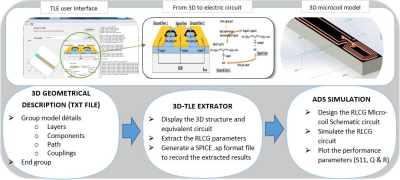 |
New approach to Improve Sensitivity of Implantable NMR microprobe through Electrical Modelization
José Antonio BERNARDO1, Abel Rangel Trejo1, Lucas Werling2, Wilfried Uhring2, Luc Hebrard2, Youssef Zaim Wadghiri3, Christian Gontrand4, and Latifa Antonio Fakri-bouchet5
1Univ Lyon, CNRS, Université Claude Bernard Lyon 1, Institut des Sciences Analytiques, UMR 5280, Villeurbanne, France, 2Icube Laboratory, UMR –CNRS 7357, Université de Strasbourg, Strasbourg, France, 3Grossman School of Medicine, New York University, New York, NY, United States, 4INL(Institut des nanotechnologies de Lyon), INSA (Institut National des Sciences Appliquées) Lyon, CNRS, Université Claude Bernard Lyon1, Villeurbanne Cedex, France, 5Univ Lyon, CNRS, Université Claude Bernard Lyon 1, Institut des Sciences Analytiques, UMR 5280, INSA Lyon (Institut National des Sciences Appliquées), Villeurbanne, France
In this study, we propose an original modelling platform 3D-TLE (Transmission Line Extractor) to determine NMR coil and microcoil performance from their geometry. Each part of our microcoil (region of interest \((ROI \sim 2µL-3µL))\), active part, Transmission Line (TL), micro-wire connection (underpass-vias) and the substrate is modelled by an electrical circuit and each contribution to the equivalent resistance is quantified. Our platform allows predicting the optimized microcoil geometry related to expected performances in terms of \(Q-factor\) and the signal-to-noise ratio \((SNR)\).
|
|||
1609.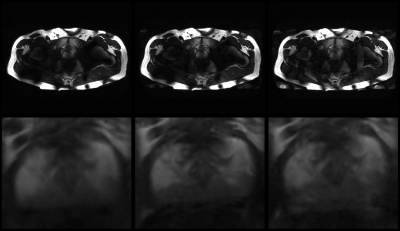 |
Exploring parallel imaging performance for prostate imaging at 7T using a 72-channel receive array
Tijl van der Velden1, Mark Gosselink1, Ingmar Voogt2, Martijn Froeling1, Hans Hoogduin1, Dennis Klomp1, Bart Steensma1, and Alexander Raaijmakers1,3
1UMC Utrecht, Utrecht, Netherlands, 2Wavetronica, Utrecht, Netherlands, 3Biomedical Engineering, Eindhoven University of Technology, Eindhoven, Netherlands
In this study we investigate the parallel imaging performance of a 72 channel body array for 7 tesla. G-factor maps and T2w prostate images have been acquired in a healthy volunteer. Accelerations of 3x3 and 4x1 are feasible without detrimental g-factor penalties.
|
|||
1610.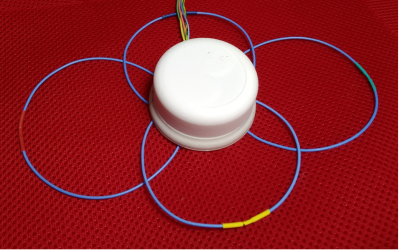 |
Coaxial coil modules as building blocks of individually arranged receive-only coil arrays
Michael Obermann1, Sigrun Roat1, and Elmar Laistler1
1High Field MR Center, Center for Medical Physics and Biomedical Engineering, Medical University of Vienna, Vienna, Austria
Close form-fitting and adaptation of the RF coil array to the target anatomy are key for obtaining high SNR. We combine ultra-flexible coaxial coils with a modular setup to achieve form-fitting by coil flexibility and adaptive coverage of the assembled array through modularity. In this work, the robustness of the coil characteristics upon reconfiguration of three modules in different array arrangements, was investigated and demonstrated its feasibility without compromise in coil performance.
|
The International Society for Magnetic Resonance in Medicine is accredited by the Accreditation Council for Continuing Medical Education to provide continuing medical education for physicians.